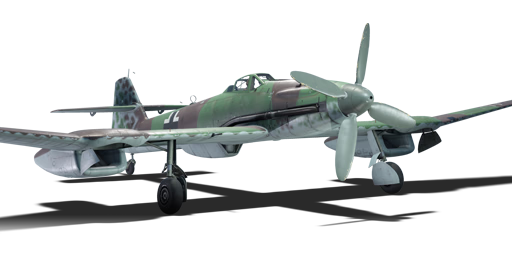


The BV 155 was one of the many designs Germany developed during World War II for high-altitude performance. It first started life with Messerschmitt, respectively called the Me 155. At this point, the Me 155 was developed to be a carrier fighter aboard the Graf Zeppelin. The Me 155 was developed with the strict goal of using as many parts from the Bf 109 as possible. It still used the DB 605 engine, and the fuselage was from the Bf 109 G variant. However, it had new wings and carrier-specific features like folding wings and an arrestor gear. Due to delays with the Graf Zeppelin, the Me 155 project was put on hold for the indefinite future. Messerschmitt continued to work on the project until the RLM (German Ministry of Aviation) saw numerous deficiencies and moved the work to Blohm & Voss.
When Blohm & Voss took control of the project, they concluded that the original design had far too many problems and a redesign was in order. The BV 155 V1 featured a new laminar flow wing as well as parts from the Ju 87 "Stuka". The canopy was also revised, and bigger radiators were fitted to remedy the cooling issues brought on by high angles of attack. Another prototype, the V2, was also being developed and was largely the same as the V1. It had the DB 603E engine, but it still didn't meet performance expectations. This led to the BV 155 V3, which would be the last 155. During the V2's development, Blohm & Voss proposed that the new DB 603U engine be put in place of the DB 603E. This would provide a substantial power increase thanks to its larger supercharger. The fate of V3 is unknown, but V1 and V2 were sent to the RAF after the war. The V1 was tested until it was written off, but the V2 is currently at the National Air and Space Museum.
The BV 155 B-1 was introduced as a reward vehicle for Battle Pass: Season VIII, "Field Testing" during Update "Danger Zone". The BV 155 performs the best at high altitudes thanks to its wing design and supercharged DB 603. However, the climb rate is quite lacklustre at only 13.8 m/s, so climbing to high altitudes will be difficult. Although the wings help the BV 155 turn tight with enough energy, it significantly hurts the roll rate. Furthermore, the BV 155 has a relatively low structural limit of 730 km/h (453 mph), which many fighters can easily exceed. The vast majority of fights in Air Realistic Battles don't happen at the altitude the BV 155 was designed to operate at, so it's quite limited in its capability.
flaps
flaps
flaps
brake
| Belt | Belt filling | Armor penetration (mm) at a distance: | |||||
|---|---|---|---|---|---|---|---|
| 10 m | 100 m | 500 m | 1000 m | 1500 m | 2000 m | ||
| HEI-T/I | 6 | 6 | 6 | 6 | 6 | 6 | |
| HEI-T/HEI-T/HEI-T/HEF-I | 4 | 4 | 4 | 4 | 4 | 4 | |
| HEI-T/HEI-T/HEI-T | 4 | 4 | 4 | 4 | 4 | 4 | |
| HEI | 4 | 4 | 4 | 4 | 4 | 4 | |
| Belt | Belt filling | Armor penetration (mm) at a distance: | |||||
|---|---|---|---|---|---|---|---|
| 10 m | 100 m | 500 m | 1000 m | 1500 m | 2000 m | ||
| IT/IT/APHE/HEI | 21 | 19 | 8 | 3 | 1 | 1 | |
| IT/HEI/HEI/AP-I | 27 | 24 | 14 | 7 | 3 | 2 | |
| AP-I/HEI/HEI/HEI/HEI/IT | 27 | 24 | 14 | 7 | 3 | 2 | |
| APHE/APHE/APHE/IT | 21 | 19 | 8 | 3 | 1 | 1 | |
| FI-T/FI-T/FI-T/IT/IT | 21 | 19 | 8 | 3 | 1 | 1 | |
| HEI/HEI/HEI/APHE/AP-I | 27 | 24 | 14 | 7 | 3 | 2 | |







 2 x (65 / 150 / 340) %
2 x (65 / 150 / 340) % 
 2 x 142 %
2 x 142 % 

Flight performance | |
|---|---|
Survivability |
|---|
Weaponry |
|---|